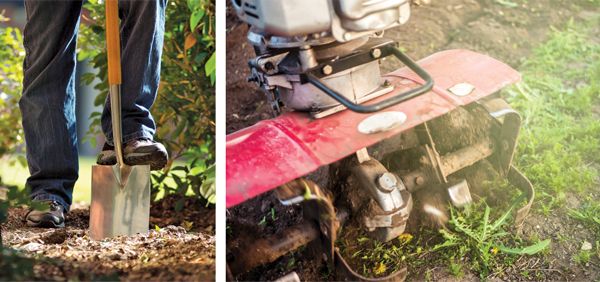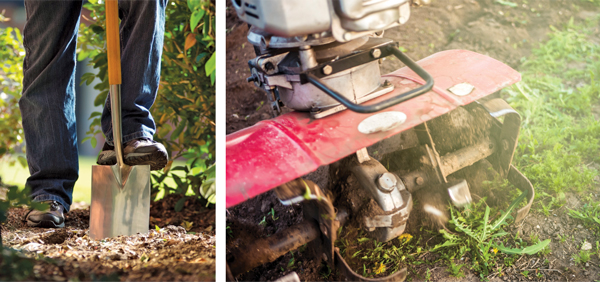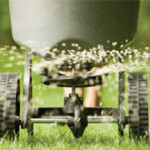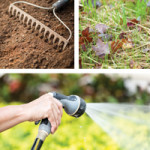Grass Is Greener | How to Grow a Lush Lawn


Although summer is over, your lawn may still be feeling the effects of children running through it, making homemade baseball diamonds, and skidding to a stop on swings. Not to mention pet damage and months of hot, dry weather. The cooler months of fall are the perfect time to rejuvenate your grass. Here’s what you need to do to ensure a lush lawn next season…
Soil samples
The first step to a healthy lawn is knowing exactly what nutrients your soil needs to germinate new growth. In Virginia, there are four common types of soil: sandy soil (coarse and grainy), clay soil (thick and putty-like), silty soil (holds water, but doesn’t dry into a clay mass), and loam (the ideal mixture of sand, clay, and silt). Each type of soil requires different nutrients for proper growth, and these nutrients can be identified with a soil test.
Soil tests do not require an expensive visit from an expert. You can perform your own test with a kit from your local Virginia Cooperative Extension office. For these tests, take soil from 10 random areas—two to four inches deep, dug with a steel or chrome-plated shovel. The samples should then be placed in a container, mixed thoroughly, and sent to be evaluated.
According to USDA data, about half of Virginia’s soil has a pH level of under five, which is too acidic for proper grass growth. In addition, 30 percent of the area has soil which is too dense to allow for proper growth of grass roots. However, both of these issues can be solved with some careful preparation before germination.
Banish weeds
While waiting for your soil results and before planting grass seed, you’ll want to remove any weeds competing for space. To avoid using potent chemicals which can be toxic to pets and beneficial insects, it’s advised to manually dig any weed patches with a flatbladed shovel. Be sure to get the roots to discourage regrowth. For large weed patches, rent a sod cutter from a local hardware store, which will remove the roots.
In situations where a lawn is filled with bare spots, rocky soil, and weeds, it may be simpler in the long run to wipe the slate clean and start over. In this case, you’ll want to rent a rototiller from a local hardware store, and use it to break up and aerate the soil to allow for new growth. But if your lawn has only minor damage and bare spots, rototilling is not necessary.
Apply ground limestone
The results of your soil test will tell you the pH and nutrient levels in your yard, and how to correct and enhance them. As mentioned, with Virginia’s often-acidic soil it’s not uncommon to see a lawn with a pH level of five. This level makes growing grass difficult, but the acidity can be neutralized with a covering of pelletized, ground limestone. Healthy lawns tolerate a pH of between 5.5 and 7.5, which commonly takes 20 to 50 pounds of ground limestone per 1,000 square feet. Strongly acidic lawns may need as much as 100 pounds. Apply lime with a spreader to be sure it is evenly distributed, walking first in one direction, then crisscrossing the other direction to get each spot covered.
Make sure you apply the correct amount based on your soil samples; otherwise, it can quickly turn into an expensive game of trial and error.
 Fertilize and seed
Fertilize and seed
Before planting grass seed, apply slow-release nitrogen fertilizer in the same way the lime was applied. In fact, lime and fertilizer can be applied together without any issues. If rototilling, till the soil after the application of lime and fertilizer to be sure the soil is properly mixed. Fertilizer should then be watered in immediately.
After fertilization, level your soil as much as possible using a rake. While raking, allow grooves to form for the optimal texture for seed germination. For grass seed, Kentucky Bluegrass is considered the best quality turf and works well in our region. It’s a cool season grass that should be planted between September 15th and November 1st, when temperatures are in the 50 to 65 degree range. It can be used to fill in any bare spots, is very resistant to wear and disease, and tends to regrow in damaged areas. In areas with more shade, a fine fescue grass can be mixed in to prevent irregular coverage.
Plant Kentucky Bluegrass at a rate of two to three pounds per 1,000 feet. Use a rotary spreader to keep application even. After seeding, rake the ground once again to be sure the seeds receive proper ground contact. Thoroughly water the entire area. Cover the ground with a thin layer of straw to hold in moisture, prevent rain from washing the seed away and to keep birds from snacking on your hard work.
It is recommended to keep the ground dark with moisture until all the seed germinates, either by hand watering or an irrigation system. After germination, the grass should receive approximately one inch of water per week and should be mowed to two-and-a-half to three inches in spring and fall; three to three-and-a-half inches during the summer.
 Overseed
Overseed
If you find that you missed some spots while seeding, you can fill in bare areas with overseeding. Mow the existing grass down low and rake to remove any dead grass or leaves. Overseed with a spreader, and apply starter fertilizer to help grass seed get established (Avoid weed-and-feed fertilizer at this time, as the pre-emergents will prevent seed germination). Then, water the area gently but thoroughly.
Preparing and seeding your lawn requires a bit of time and effort. But, once germinated, Kentucky Bluegrass is hardy and will stand tall against wear and tear, and will keep your lawn looking good in the seasons ahead. Remember, the grass isn’t greener on the other side; it’s greener where you water it.
clay soil, Fertilize, fescue grass, garden, Kentucky Bluegrass, limestone, loam, manually dig, Overseed, rototiller, sandy soil, seed, Soil tests






